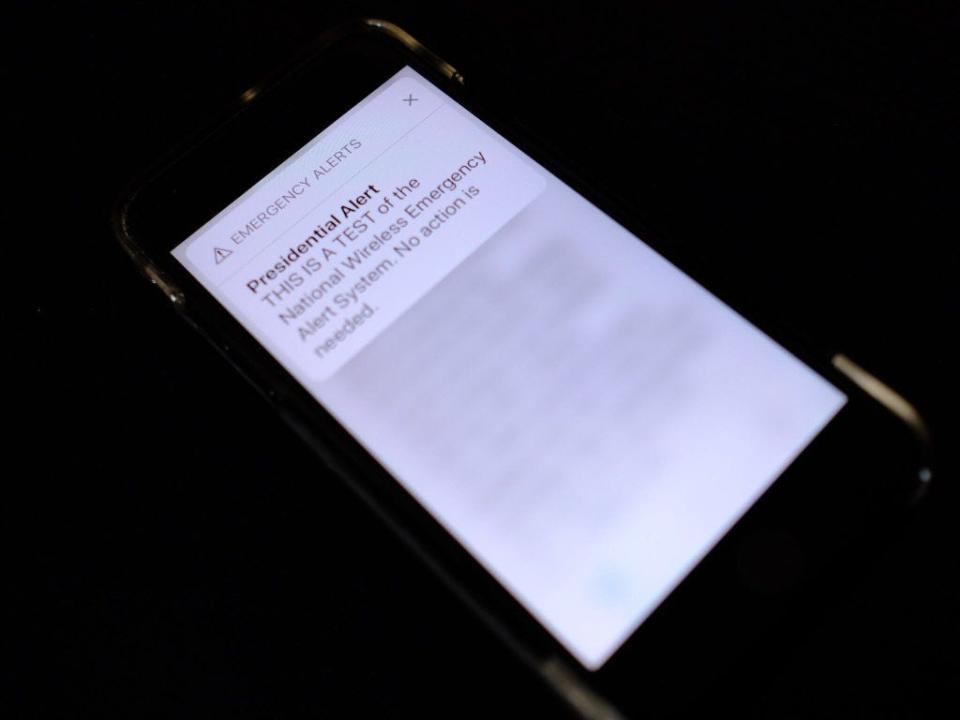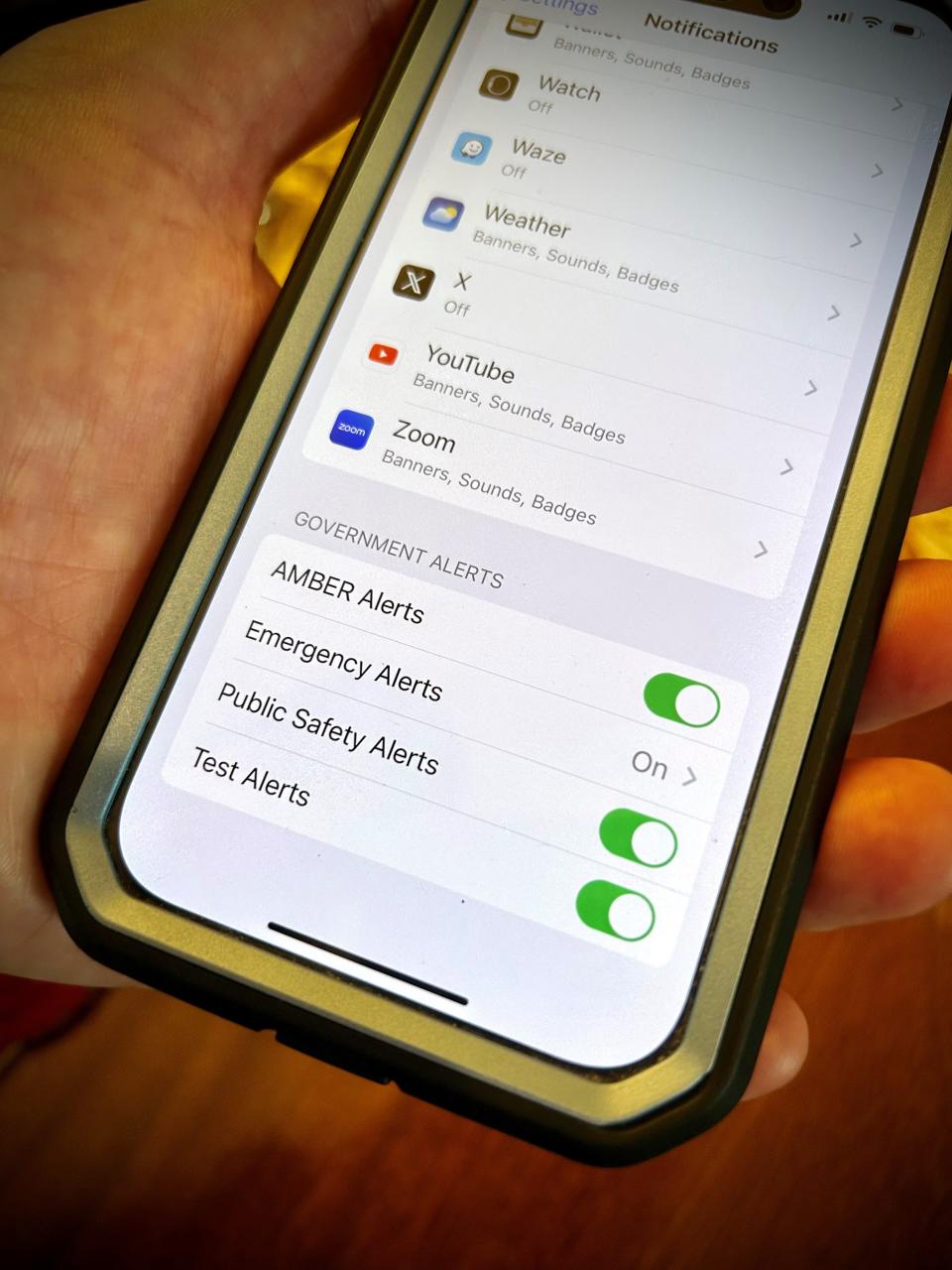What was that noise? FEMA, FCC emergency alert test jolts devices nationwide
Millions of cell phones, TVs and radios in the United States blared distinctive emergency alert tones for about a minute at 2:18 p.m. EDT Wednesday, followed by the message: "THIS IS A TEST of the National Wireless Emergency Alert System. No action is needed."
The test went off without a hitch – to cell phones at 2:18 p.m. EDT and to television and radio stations at 2:20 p.m. EDT.
"The test went extremely well," said Antwane Johnson, acting deputy assistant administrator for FEMA’s National Continuity Programs Directorate. "Every phone lit up in the room."
It also happened in the White House briefing room, where phones began ringing out the warning tone at 2:18 p.m. just as White House press secretary Karine Jean-Pierre was in the middle of a briefing about aid to Ukraine.
"There you go," she said as reporters waited for their phones to quiet so the briefing could continue. "It works."
The alert was the first Nationwide Emergency Alert Test since 2018. It was intended by the Federal Emergency Management Agency and the Federal Communications Commission to alert all Americans across all time zones at once in the event of a national calamity.
Cell phones, vibrated and displayed, "THIS IS A TEST of the National Wireless Emergency Alert System. No action is needed.”
Phones in Spanish displayed: “ESTA ES UNA PRUEBA del Sistema Nacional de Alerta de Emergencia. No se necesita acción.”

How does the system work?: An emergency alert test will hit all phones Wednesday. How the wireless system works.
Why did FEMA, FCC test the alert?
The two federal agencies said they tested the system to ensure the national alert system is still an effective means of warning Americans about emergencies, national catastrophes, attacks and accidents at the national level.
Why was the test two minutes early?
Information from the Federal Communications Commission and the Federal Emergency Management Agency had said "The tests are scheduled for Oct. 4, 2023, at approximately 2:20 pm EDT."
But people got the message at 2:18 pm EDT. Was it a mistake?
It wasn't. There were actually two parts to the national test, one that went out to cell phones and one that went out to radio and television systems.
The cell phone test went out at 2:18 pm EDT, which was what the Federal Communications Commission had long planned. FCC issued a memo dated Aug. 3 noting that the test would occur at 2:18 p.m. EDT, which was within the timing given by FEMA.
The television and radio test went out at 2:20 p.m. EDT, said Antwane Johnson, acting deputy assistant administrator for FEMA’s National Continuity Programs Directorate.
The two-minute wait between the two had always been planned, he said, but the slight lack of clarity was possibly "a miscommunication," he said.
I got the message late, how is that possible?
If a phone was turned off when the original message was sent out but then turned on within the 30 or so minute window within which the message was active in the system, "those phones should have gotten it as well," said Johnson.
Was the alert sent if I turned off my phone during the test?
If your cellphone was set to Wi-Fi or airplane mode, it wouldn't have received the alert because the message relies on the cellular broadcast system.
Only cell phones powered on received the message. That is likely to help someone living in an unsafe situation who has a hidden phone. Many domestic violence organizations have issued warnings locally and nationally leading up to the test.

Test for security threatens safety: Wednesday's emergency alert may be annoying to some. For abuse victims, it may be dangerous
Did the test activate graphene oxide particles?
No. USA TODAY rated this claim as false on Sept 29.
The claim spread in a Sept. 20 Instagram post of a man who warned people to power down their phones to avoid the exposure. But the alert and signals used to start it posed zero health risks.
More: Emergency alert controversy: No risk FEMA alert will activate body's chemicals | Fact check
FEMA is unaware of any adverse health effects caused by the signal, Edwards said.
“In what world can some sort of FEMA alert system activate some sort of compound in our bodies, in billions of people?” Dr. Thomas Russo, chief of the division of infectious diseases at the University at Buffalo’s Department of Medicine, told USA TODAY. “It’s just not plausible.”
Was anyone turned into a zombie by the test?
There are multiple conspiracy theories online about the emergency test, including one suggesting the tone used to announce the alert could somehow activate viruses in people who have been vaccinated, turning them into zombies.
"I received it on my phone and saw it on the TV. And I can confirm to you that I am not a zombie," said Jeremy Edwards, press secretary and deputy director of public affairs at FEMA.
Why you shouldn't turn off your phone's ability receive alerts
Some cellphone users have turned off alerts on their phones but Johnson implored them not to – because while the national tests happen only every few years, local alerts bring vital, important and geographically targetted information.
"I understand that some folks may consider them an inconvenience or maybe a minor annoyance, but the whole point of these tests is to ensure that people are able to be reached when there's an emergency, so they can protect themselves and their family," he said.
"If you turned off your device or you turn off your notifications, you would never see the alert today," he said. "We hope that you turn those back on in the event that there is a flooding event next week or you find yourself in the middle of America as a tornado threatens or another weather alert or there is an Amber Alert in your area."
Contributing: Elizabeth Weise, Joedy McCreary, Mary Walrath-Holdridge, USA TODAY.
This article originally appeared on USA TODAY: Emergency alert test from FEMA, FCC blares from phones, other devices


